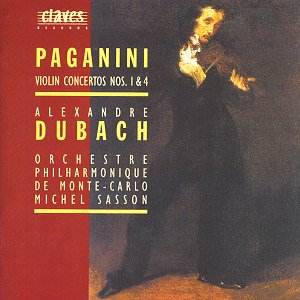This is almost a case of once you have heard one you
have heard them all, for there’s a pretty predictable formulaic structure
to the concertos, six of eight having survived. The orchestra generally
sets out its stall at the start of the first movements (always the longest
of the three in each concerto) after which it adopts a fairly dull role,
leaving the soloist to his pyrotechnics. Given that Paganini was supposed
to be the Devil incarnate with fiddle in hand, the demands are clearly
going to be, and are, formidable. It’s not quite a matter of course
to listen to them in numerical order, as No.6 was probably the first
to be written, and only the solo part has survived, so in this case,
and that of the fifth concerto, Federico Mompellio orchestrated them
in 1959 and 1972 respectively. In all the concertos Alexandre Dubach,
not a name which is as familiar as his ability revealed here would pre-suppose,
provides his own cadenzas.
Paganini’s style is almost Rossinian, indeed after
the orchestra’s laying out of the material in No.1 (including the obligatory
participation of the cymbal and the single trombone), one expects a
soprano or tenor to join the fray. All the 19th century virtuosic
traits make their appearances, such as double stops (cd 50-9204 Track
6: 02’.00"), left hand pizzicato (cd 50-9408 Track 6: 06’20"),
spiccato or ricochet bowing, and flights up to the dizzy heights and
down to the open G string at mega-speeds. Indeed it is a showcase for
a violin school comparable to that created by his German contemporary
Spohr. Paganini’s tongue is firmly in his cheek at the two-note answers
to the solo violin by the trumpet, then the trombone in the finale to
this first concerto (cd 50-9204 Track 6: 06’.00" and 06’.20"),
whose main theme incidentally sounds as if he had just heard Beethoven’s
Triple Concerto, written ten years earlier. Generally the slow movements
hardly exploit the lyrical warmth of the instrument in the way that
the Germans Mendelssohn, Bruch and Brahms came to do, but the most exciting
fireworks are reserved for the finales, with examples of Eastern European
dance such as Polkas to add exoticism to the irresistible mix. Indeed
the soloist could have been either an opera singer or ballet dancer
if not a violinist in these works, which point the way to Sarasate and
Wieniawski later in the century.
The third concerto (cd 50-9503, tracks 1-3) was only
rediscovered in 1971, and is curious in that each movement begins with
the orchestra’s strings playing pizzicato. But of the six concertos,
the most familiar to listeners will be the finale to No.2 (cd 50-9408
Track 6), the so-called ‘La Campanella’, which became a real hit in
Paganini’s day and immediately re-appeared in transcriptions as galops,
waltzes and fantasies for piano, Liszt’s the most famous and successful.
This finale encapsulates all of the effects and singular style of its
effervescent bravura and Alexandre Dubach is more than a match for the
demands, while the orchestra supports dutifully, there’s not much more
they can do. The only thing missing after each concerto’s finale is
the roar of applause from an adoring audience, for that’s what Paganini
would have been expecting.
Christopher Fifield

